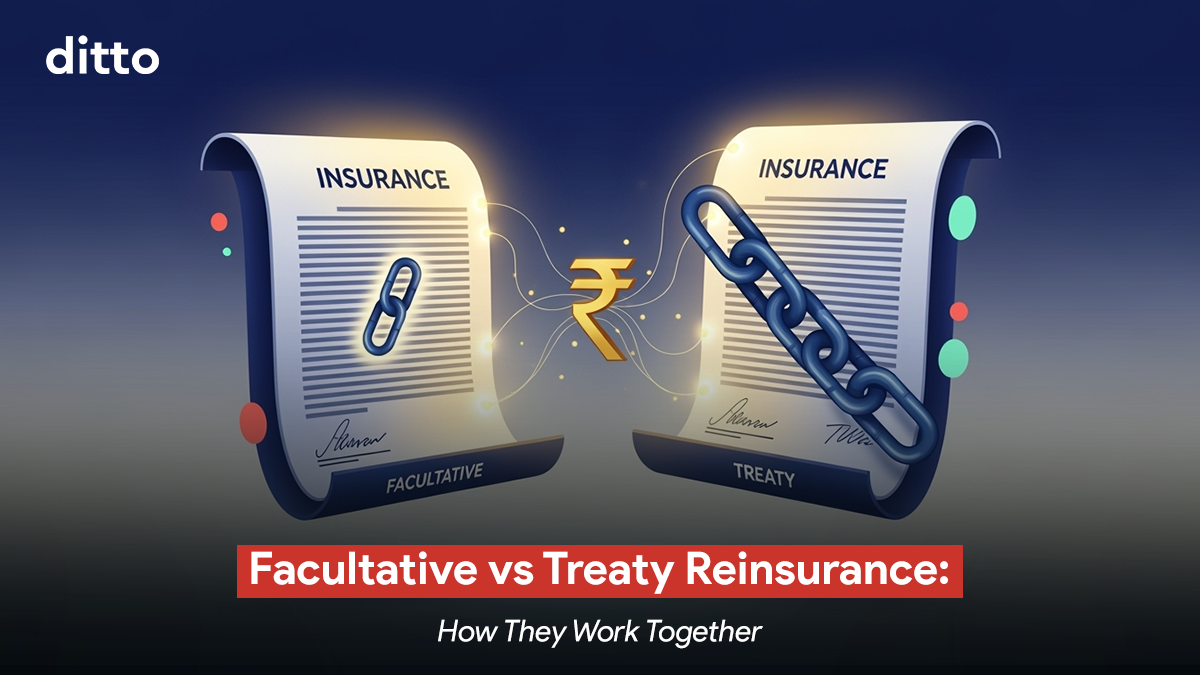| What is Facultative vs Treaty Reinsurance? Facultative reinsurance covers individual, high-value, or unusual risks, while treaty reinsurance automatically covers a whole portfolio of similar policies. Together, they allow insurers to handle both rare, high-value risks and regular, everyday policy perils, and help keep the insurance system stable and dependable. |
Facultative vs Treaty Reinsurance: Introduction
In the complex world of insurance, managing risk is paramount. Two fundamental concepts that every insurer relies on to mitigate their risk exposure are Facultative reinsurance and Treaty reinsurance. Together, they form the backbone of risk sharing and financial stability in the insurance ecosystem.
This guide will take a deep dive into the nuances of Facultative vs Treaty Reinsurance to provide clarity on how these two mechanisms differ, complement each other, and support insurers in managing diverse portfolios and high-value risks.
If you need guidance on health or term insurance, reach out to Ditto and book a free call. Our experts will walk you through every step and help you make the best decisions for your coverage.
What is Facultative vs Treaty Reinsurance?
The phrase Facultative vs Treaty Reinsurance represents two distinct approaches insurers use to transfer risk to reinsurers. Facultative reinsurance is risk-specific and negotiated case-by-case, while treaty reinsurance is a broader agreement covering entire portfolios of policies under predefined terms.
Understanding Facultative vs Treaty Reinsurance is important not only for insurance professionals but also for policyholders who care about the stability and reliability of their insurers. These two types of reinsurance help insurers to share parts of their risk to stay solvent and pay claims efficiently, particularly when faced with large, unique, or catastrophic losses.
What is Facultative Reinsurance and How Does It Work?
Facultative reinsurance is a tailored risk management tool. Instead of covering everything under one big agreement, the primary insurer can hand-pick certain risks and offer them to a reinsurer for review.
This approach is used when dealing with very large, uncommon, or highly serious risks that go beyond what a standard insurance agreement can cover. In simpler terms, the usual insurance deal has a limit on how much it will pay, but for these special cases, that limit is not enough to protect against the full amount of possible losses. Examples include mega infrastructure projects, offshore oil platforms, or unique high-value properties, all of which are too large or unusual to fit comfortably within a typical treaty.
In the Facultative vs Treaty Reinsurance context, facultative deals act like a pressure-release valve that allows insurers to transfer specific, unusually large risks without disrupting their overall treaty agreements. Because the reinsurer reviews each facultative risk individually and decides whether to accept it and under what conditions, this type of reinsurance offers greater flexibility but also involves more administrative work.
Real-World Examples of Facultative Reinsurance
- Airbus A380 Launch (2000s): When Airbus introduced the A380 superjumbo, each plane was worth around $350–400 million which is way more than what standard treaty coverage could handle. Insurers had to arrange facultative reinsurance for each plane to cover both the aircraft itself and the potential liability.
- Offshore Oil Platforms – Deepwater Horizon (2010, BP): The Deepwater Horizon disaster in the Gulf of Mexico caused over $1.5 billion in insured losses. Much of this risk was handled with facultative reinsurance, especially in the London and Bermuda markets, because treaty coverage couldn’t handle such a huge, concentrated offshore energy risk.
- Olympic Games / FIFA World Cup: Big events like the Olympics or the FIFA World Cup are insured for billions of dollars, covering everything from stadiums to liability and event cancellation. These policies often need facultative reinsurance because the amounts and unique risks like terrorism, cancellations, or pandemics are usually beyond what treaties can cover.
What is Treaty Reinsurance and How Does It Work?
Treaty reinsurance works more like an ongoing partnership. Instead of negotiating risk one policy at a time, the primary insurer and reinsurer agree in advance to share entire groups of risks automatically. This makes the process smoother, faster, and much more predictable.
Treaty reinsurance is especially useful for handling large volumes of similar, everyday policies like home or auto insurance because it spreads risk consistently. Unlike facultative reinsurance, there’s no need for the reinsurer to review each policy. This saves time and makes it highly scalable.
In short, treaty reinsurance helps insurers keep their portfolios steady and gives them the confidence to underwrite new business.
Real-World Examples of Treaty Reinsurance
- Motor Insurance in India: Big Indian insurers like New India Assurance, ICICI Lombard, and HDFC Ergo use treaty reinsurance for motor insurance. This means a set percentage of every car insurance policy (both third-party and own-damage) is automatically shared with reinsurers. It helps them manage millions of policies smoothly and keeps things stable.
- Health Insurance in Asia: In countries like India, China, and Indonesia, insurers rely on excess-of-loss health treaties. For example, if a medical claim goes over ₹5 lakh in India, the reinsurer covers the rest. This lets insurers confidently offer millions of health policies without needing to arrange facultative coverage for each one.
- Property Catastrophe Treaties – Florida Hurricanes: In the US, property insurers use catastrophe treaties for hurricane risks. After Hurricane Ian in 2022, these treaties covered billions in claims, helping local insurers stay in business. Without them, many regional companies could have gone bankrupt.
| Do you know who helps stabilize insurers during big claims in India? It’s GIC Re (General Insurance Corporation of India), the country’s national reinsurer. Established in 1972, GIC Re acts as a safety net for insurance companies, taking on a portion of their risks and stepping in during large-scale events, like natural disasters or major accidents, to help insurers stay financially stable. |
Key Differences Between Facultative and Treaty Reinsurance
| Aspect | Facultative Reinsurance | Treaty Reinsurance |
|---|---|---|
| Scope | Individual, high-value or unique risks | Entire portfolio or category of risks |
| Risk Assessment | Case-by-case underwriting by reinsurer | Automatic acceptance under agreed terms |
| Use Case | Large, unusual, or high-severity exposures | Homogeneous, repetitive risks |
| Administration | More complex and time-consuming | Streamlined and efficient |
| Capacity | Supplements treaty limits for large single risks | Primary backbone for broad risk coverage |
| Flexibility | High, tailored solutions | Standardized, formula-based agreements |
| Regulatory Monitoring | Facultative reliance is regulated to avoid excess | Encouraged as the foundation of risk programs |
| Examples | Mega projects, offshore rigs, sporting events | Motor, health, property insurance portfolios |
How Facultative vs Treaty Reinsurance Work Together?
In the facultative vs treaty reinsurance battle, it is easy to forget that they are designed to complement each other. You can think of them as two different tools an insurance company uses to handle big risks.
A treaty is like a big safety net that automatically covers groups of similar policies, say, thousands of car insurance policies. But this safety net has limits. Once the treaty is full, the insurer can’t rely on it anymore for extra-large or unusual risks.
That’s where facultative reinsurance comes in. It’s like adding an extra patch of coverage on top, giving the insurer more room to handle something outside the treaty like a skyscraper, a bridge, or an oil platform.
Regulators want insurers to use facultative reinsurance only as extra support, not as a total replacement for treaties. This way, companies keep their main safety net (treaty reinsurance) strong and steady, but still have the flexibility to deal with the unusual stuff when it shows up.
| Did You Know? The Insurance Regulatory and Development Authority of India (IRDAI) requires insurers to disclose their reinsurance strategy in detail, as outlined in their official circular, including how much facultative and treaty reinsurance they use. This helps IRDAI ensure insurers don’t rely too much on facultative reinsurance, which is more flexible but also more complex. Insurers are required to keep detailed records of the risks they pass on to reinsurers and regularly report the treaties they have in place. This helps make sure their reinsurance plans align with solvency requirements, meaning they have enough financial strength to pay claims. IRDAI also has clear approval processes and limits to keep the whole system structured and transparent. So, reinsurance in India isn’t just a behind-the-scenes deal, it’s a regulated practice that protects policyholders and keeps insurers stable. Explore IRDAI’s role in reinsurance and its regulatory framework. |
Benefits of Facultative and Treaty Reinsurance
The combination of facultative vs treaty reinsurance enables insurers to optimize their risk portfolios effectively. Here are some key benefits:
- Risk Diversification: Facultative reinsurance allows insurers to handle unique, large single risks that a treaty cannot cover alone.
- Portfolio Stability: Treaty reinsurance evens things out across lots of similar policies, like thousands of cars or homes, which in turn makes claims easier to predict and manage.
- Capacity Expansion: Together, both tools increase an insurer's ability to underwrite more business and larger policies than they could with just one type of reinsurance.
- Regulatory Compliance: Strategic use of facultative and treaty reinsurance helps insurance companies meet the rules for how much money they need to keep on hand.
- Operational Efficiency: Treaty reinsurance handles large batches of policies automatically, while facultative steps in for the unusual cases, so everything runs more smoothly.
- Financial Stability: Both facultative and treaty reinsurance support an insurer’s cash flow and make sure the insurer has enough money to pay claims, even during disasters or when lots of claims happen at once.
Why Talk to Ditto for Your Insurance?
At Ditto, we’ve assisted over 8,00,000 customers with choosing the right insurance policy. Why customers like Tharun below love us:

✅No-Spam & No Salesmen
✅Rated 4.9/5 on Google Reviews by 15,000+ happy customers
✅Backed by Zerodha
✅Dedicated Claim Support Team
✅100% Free Consultation
Conclusion
How an insurance company uses facultative and treaty reinsurance can make a big difference in how strong and flexible it is. Facultative reinsurance is like a custom solution for unusual, high-value risks. Treaty reinsurance, on the other hand, is the steady backbone, handling large groups of regular policies automatically.
Used together, these two types of reinsurance create a smart balance: stability for everyday risks and flexibility for the unusual ones. For insurers, getting the facultative vs treaty reinsurance balance right is key to growing safely and managing risks well. And for policyholders, knowing the difference helps give confidence that their insurance company can pay claims, even in extreme or unexpected situations.
We hope this guide helped you understand how reinsurance works and why insurers rely on it to stay secure.
If you need guidance on health or term insurance, reach out to Ditto and book a free call. Our experts will walk you through every step and help you make the best decisions for your coverage.
FAQs on Facultative vs Treaty Reinsurance
What is the primary difference between facultative and treaty reinsurance?
Facultative reinsurance covers individual risks on a case-by-case basis, while treaty reinsurance automatically covers a portfolio of risks under agreed terms.
Can facultative reinsurance replace treaty reinsurance?
No, facultative reinsurance supplements treaty programs. It provides extra capacity for large or unusual risks beyond treaty limits.
Why do insurers prefer treaty reinsurance for health and motor portfolios?
Because these portfolios consist of numerous standardized policies, treaty reinsurance offers predictable, automatic risk transfer without requiring individual assessment.
How does facultative reinsurance benefit mega infrastructure projects?
Such projects often exceed treaty capacity due to their size and complexity, so facultative reinsurance allows insurers to share risk specifically for these high-value exposures.
What does reinsurance mean?
Reinsurance is when an insurance company (the “primary insurer”) passes part of its risk to another company (the “reinsurer”) to protect itself from large losses. Facultative and treaty are two main types of reinsurance.
Why is reinsurance needed?
Reinsurance helps insurance companies manage big risks and protect themselves from large or catastrophic losses. By sharing some of their risk with reinsurers, insurers can stay financially stable, free up money, and take on more policies. Without it, they might struggle to cover high-value or many risks. Facultative vs treaty reinsurance are two key ways insurers share risk to keep the insurance system stable and resilient.
Last updated on:







